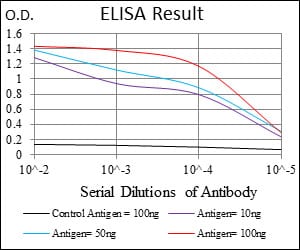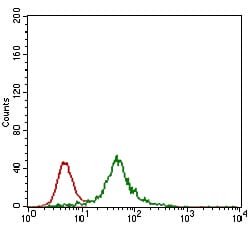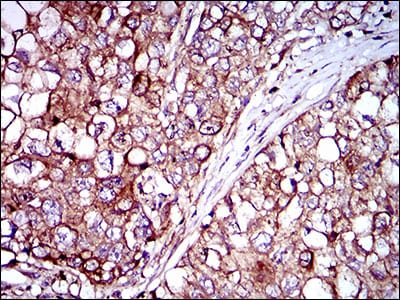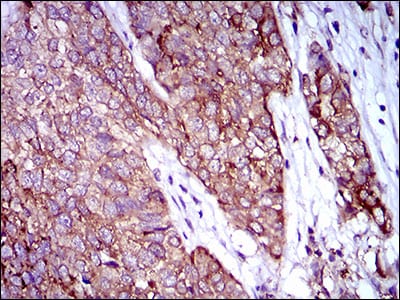




| WB | 1/500 - 1/2000 | Human,Mouse,Rat |
| IF | 咨询技术 | Human,Mouse,Rat |
| IHC | 1/200 - 1/1000 | Human,Mouse,Rat |
| ICC | 技术咨询 | Human,Mouse,Rat |
| FCM | 1/200 - 1/400 | Human,Mouse,Rat |
| Elisa | 1/10000 | Human,Mouse,Rat |
| Aliases | REX1; ZNF754 |
| Entrez GeneID | 132625 |
| clone | 5E11A6 |
| WB Predicted band size | 34.8kDa |
| Host/Isotype | Mouse IgG1 |
| Antibody Type | Primary antibody |
| Storage | Store at 4°C short term. Aliquot and store at -20°C long term. Avoid freeze/thaw cycles. |
| Species Reactivity | Human,Mouse |
| Immunogen | Purified recombinant fragment of human ZFP42 (AA: 249-310) expressed in E. Coli. |
| Formulation | Purified antibody in PBS with 0.05% sodium azide |
+ +
以下是关于ZFP42(REX1)抗体的3篇参考文献及其摘要概括:
---
1. **文献名称**:*ZFP42 is a key regulator of pluripotency in human embryonic stem cells*
**作者**:Kim et al. (2021)
**摘要**:本研究通过免疫荧光和Western blot技术,利用ZFP42抗体验证其在人胚胎干细胞中的核定位及表达水平,证实ZFP42通过调控OCT4和NANOG维持多能性,抗体特异性经siRNA敲低实验验证。
---
2. **文献名称**:*REX1/ZFP42 as an epigenetic modulator in early lineage commitment*
**作者**:Rodriguez-Terrones et al. (2018)
**摘要**:文章使用ZFP42抗体进行染色质免疫沉淀测序(ChIP-seq),揭示其在胚胎干细胞分化过程中靶向发育相关基因启动子区域,调控DNA甲基化及组蛋白修饰,影响中胚层和内胚层分化路径。
---
3. **文献名称**:*Comparative analysis of pluripotency markers in induced pluripotent stem cells*
**作者**:Nakagawa et al. (2015)
**摘要**:研究比较多种多能性标志物抗体(包括ZFP42抗体)的特异性,通过流式细胞术和免疫组化证明ZFP42在iPSCs中高表达,但在分化后显著下降,提示其作为多能性质量控制的可靠标志物。
---
4. **文献名称**:*Antibody validation for stem cell research: A case study of ZFP42/REX1*
**作者**:Thompson et al. (2020)
**摘要**:系统评估了市售ZFP42抗体的特异性,通过基因敲除细胞系和肽段竞争实验确认抗体可靠性,为干细胞研究中的抗体选择提供标准化流程。
---
以上文献均涉及ZFP42抗体的实验应用,涵盖多能性调控、分化机制及抗体特异性验证等领域。
**Background of ZFP42 Antibody**
The ZFP42 antibody targets the ZFP42 protein, also known as Zinc Finger Protein 42 or REX1 (Reduced Expression Protein 1), encoded by the *ZFP42* gene in humans. ZFP42/REX1 is a transcription factor containing tandem Cys2-His2 zinc finger domains, primarily recognized for its role in maintaining pluripotency in embryonic stem cells (ESCs). It is a downstream target of core pluripotency regulators like OCT4. SOX2. and NANOG, and its expression is tightly associated with the undifferentiated state of ESCs. During early embryonic development, ZFP42 is highly expressed in the inner cell mass of blastocysts but is downregulated upon differentiation, making it a key marker for pluripotency.
ZFP42 antibodies are widely used in stem cell research to identify and characterize pluripotent cells via techniques such as immunocytochemistry, Western blotting, and flow cytometry. These antibodies help assess the quality of induced pluripotent stem cells (iPSCs) or ESCs by confirming the presence of ZFP42 protein, which correlates with their undifferentiated status. Additionally, ZFP42 has been implicated in regulating genomic imprinting and telomere maintenance, with aberrant expression linked to certain cancers and developmental disorders.
Commercial ZFP42 antibodies are typically validated for specificity using knockout cell lines or siRNA-mediated knockdown to ensure minimal cross-reactivity. Their application extends to developmental biology, regenerative medicine, and disease modeling, underscoring their importance in understanding cellular reprogramming and lineage commitment.
×